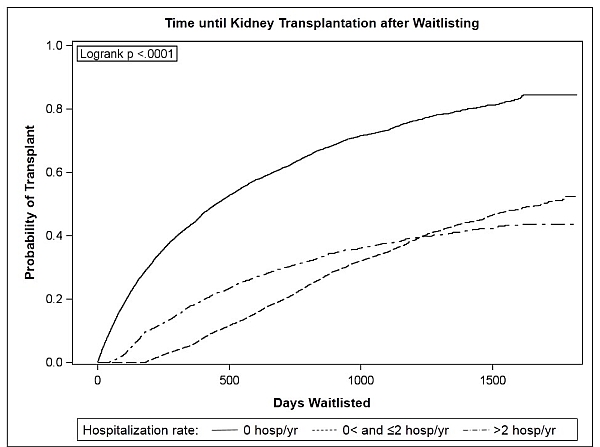Racial/Ethnic Differences in the Association Between Hospitalization and Kidney Transplantation Among Waitlisted End Stage Renal Disease (ESRD) Patients: A Multi-Level Mixed Modeling Approach
1Emory University Rollins School of Public Health, Atlanta
2Emory University School of Medicine, Atlanta.
Meeting: 2015 American Transplant Congress
Abstract number: C30
Keywords: African-American, Hispanic, Kidney transplantation, Waiting lists
Session Information
Session Name: Poster Session C: Disparities in Healthcare Access
Session Type: Poster Session
Date: Monday, May 4, 2015
Session Time: 5:30pm-6:30pm
 Presentation Time: 5:30pm-6:30pm
Presentation Time: 5:30pm-6:30pm
Location: Exhibit Hall E
Background: Racial disparities in access to kidney transplantation exist among End Stage Renal Disease (ESRD) patients, even after placement on the deceased donor waitlist. One hypothesis is that the discrepancy exists because minorities have more severe disease or more comorbidities once waitlisted, and therefore are less likely to be transplanted. The role of hospitalization, which may be a proxy for disease severity or illness, on kidney transplant disparities has not been investigated.
Methods: We used United States Renal Data System (USRDS) Medicare-linked data on waitlisted ESRD patients between 2005 and 2009 with continuous enrollment in Medicare Parts A & B (n=23,845) to examine the association between annual hospitalization rate and odds of receiving a kidney transplant. We used multi-level random effects models to estimate odds ratios (OR) and 95% confidence intervals (CI), controlling for individual-, transplant center-, and organ procurement organization-level clustering.
Results: Compared to individuals who were not hospitalized, patients who were hospitalized while on the waitlist were less likely to be transplanted (Figure 1; 1-2 vs. 0 hospitalizations/year among non-Hispanic whites OR=0.25, blacks OR=0.38, Hispanic whites OR=0.33; all p<0.001).  Regardless of hospitalization, blacks were less likely to receive kidney transplant. The disparity was greatest for those who were never hospitalized while waitlisted (blacks vs. non-Hispanic whites OR=0.46, p<0.001; Hispanic whites vs. non-Hispanic whites OR=0.68, p<0.001) and narrowed when comparing hospitalized individuals (1-2 hospitalizations/year blacks vs. non-hispanic whites OR=0.70, p<0.001; Hispanic whites vs. non-Hispanic whites OR=0.92, p=0.579).
Regardless of hospitalization, blacks were less likely to receive kidney transplant. The disparity was greatest for those who were never hospitalized while waitlisted (blacks vs. non-Hispanic whites OR=0.46, p<0.001; Hispanic whites vs. non-Hispanic whites OR=0.68, p<0.001) and narrowed when comparing hospitalized individuals (1-2 hospitalizations/year blacks vs. non-hispanic whites OR=0.70, p<0.001; Hispanic whites vs. non-Hispanic whites OR=0.92, p=0.579).
Conclusion: Individuals who are hospitalized while waitlisted are less likely to receive a transplant. However, hospitalization does not fully account for the racial disparity in kidney transplantation.
To cite this abstract in AMA style:
Newman K, Fedewa S, Jacobson M, Adams A, Zhang R, Patzer R. Racial/Ethnic Differences in the Association Between Hospitalization and Kidney Transplantation Among Waitlisted End Stage Renal Disease (ESRD) Patients: A Multi-Level Mixed Modeling Approach [abstract]. Am J Transplant. 2015; 15 (suppl 3). https://atcmeetingabstracts.com/abstract/racialethnic-differences-in-the-association-between-hospitalization-and-kidney-transplantation-among-waitlisted-end-stage-renal-disease-esrd-patients-a-multi-level-mixed-modeling-approach/. Accessed December 21, 2025.« Back to 2015 American Transplant Congress
